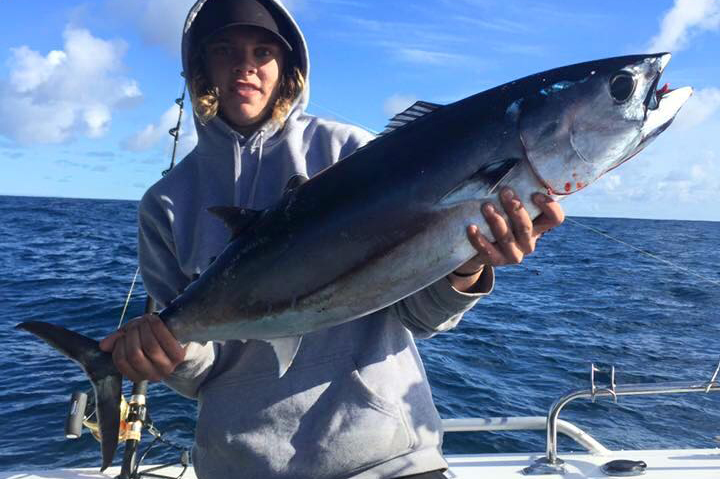Slender Tuna, Allothunnus fallai Serventy 1948

Dermott Yawney with a Slender Tuna, Allothunnus fallai, caught by him and his brother Andrew, off Port Fairy, Victoria, 9 July 2016. Source: Andrew Yawney / Warrnambool Offshore & Light Game Fishing Club. License: All rights reserved
A slender dark bluish that lacks spots and stripes, and has a deep purple or almost black head, silvery-white sides and belly, and purple pectoral and pelvic fins with black inner sides.
This active cool to cold water species feeds heavily on krill and is taken on longlines set for Southern Bluefin Tuna. The flesh very oily but paler than most other true tunas, making it more suitable for canning than fresh consumption. Although relatively common in southern waters, the Slender Tuna is rarely caught by game fishers.
Slender Tuna, Allothunnus fallai Serventy 1948
More Info
|
Distribution |
Known from the southern half of Australia, reportedly from off southern Queensland, to Shark Bay, Western Australia, although common only along the southern coast. Elsewhere the species is circumglobal in the southern hemisphere between latitudes of 20-50° S - occasionally forming schools. Juveniles usually occur at in latitudes of 20-35°S, in water temperatures ranging from 19-24°C. As they grow, individuals migrate to colder water at higher latitudes, also undertaking seasonal migrations seemingly to follow plankton concentrations. Appears to be common off the east coast of Tasmania. |
|
Features |
Dorsal fin XVI–XIII + 11–13, + 7–8 finlets; Anal fin 13–14, + 6–7 finlets; Caudal fin 17; Pectoral fin 25–28; Pelvic fin I, 5; Gill rakers (first arch) 70–80; Vertebrae 40. Body elongate, robust, body depth 19–23% FL; caudal peduncle with prominent lateral keel and smaller keel above and below on base of tail; mouth extending to below anterior half of eye; jaw teeth small, conical, 40–55 on side, fine teeth on palatines. Modified elongate corselet of scales from pectoral-fin region along back to posterior end of 2nd dorsal fin, small scales behind and above lateral line, absent below. Dorsal fins close together, 1st dorsal-fin base about 3 times length of 2nd; 2nd dorsal and anal fins tall, pointed, almost opposite; caudal fin lunate; pectoral and pelvic fins short, pointed; interpelvic process short and bifid. |
|
Size |
Reaches at least 105 cm FL (fork length) and 13.7 kg in weight. |
|
Colour |
Blue-green dorsally, silvery-white on sides and ventrally. |
|
Feeding |
Carnivore - feeds mainly on krill (euphausids), and also on squids, small fishes and other small crustaceans. |
|
Biology |
The biology is poorly known. Spawning reportedly occurs during summer from late October through December in tropical waters of the Indian and South Pacific oceans north of 31°S. |
|
Fisheries |
Due to its oily flesh, there is no dedicated fishery for the Slender Tuna. It is mainly taken as bycatch on tuna longlines, largely in the Southern Bluefin Tuna Fishery. Catches are small due to its plankton-feeding behaviour. Although the flesh is very oily and pale, it is reportedly fine eating when cooked. |
|
Conservation |
IUCN Red List of Threatened species: Least Concern |
|
Remarks |
This species has a "brain heater" consisting of extraoccular muscles that are capable of raising cranial temperatures by 4.8 degrees above ambient temperature. |
|
Species Citation |
Allothunnus fallai Serventy 1948, Rec. Canterbury Mus. 5(3): 132, pls 28-29, Timaru, South Island, New Zealand. |
|
Author |
Bray, D.J. & Schultz, S. 2025 |
|
Resources |
Slender Tuna, Allothunnus fallai Serventy 1948
References
Cao, C., Miskiewicz, A.G., Appleyard, S.A., Matis, P., Schilling, H. & Suthers, I. 2022. Tuna Larvae (Scombridae) off Eastern Australia: When and Where Are They Spawned? Biology and Life Sciences Forum 13(1): 66. https://doi.org/10.3390/ blsf2022013066
Collette, B.B. 2001. Scombridae. pp. 3721-3756 in Carpenter, K.E. & Niem, T.H. (eds). The Living Marine Resources of the Western Central Pacific. FAO Species Identification Guide for Fisheries Purposes. Rome : FAO Vol. 6 pp. 3381-4218.
Collette, B.B. & Chao, L.N. 1975. Systematics and morphology of the bonitos (Sarda) and their relatives (Scombridae, Sardini). Fishery Bulletin (U.S.) 73(3): 516-625 figs 1-70
Collette, B.B. & Nauen, C.E. 1983. FAO species catalogue. Scombrids of the world. An annotated and illustrated catalogue of tunas, mackerels, bonitos and related species known to date. Fisheries Synopsis No. 125, Vol. 2. Rome : FAO. 137 pp. 81 figs
Fraser-Brunner, A. 1950. The fishes of the family Scombridae. Annals and Magazine of Natural History 12 3(7): 131-163 figs 1-35
Gomon, M.F. 2008. Families Sphyraenidae to Centrolophidae. pp. 774-800 in Gomon, M.F., Bray, D.J. & Kuiter, R.H. (eds). Fishes of Australia's Southern Coast. Sydney : Reed New Holland 928 pp.
Graham, J.B. & Dickson, K.A. 2000. The evolution of thunniform locomotion and heat conservation in scombrid fishes: new insights based on the morphology of Allothunnus fallai. Journal of the Linnean Society of London, Zoology 129: 419-466.
Last, P.R., Scott, E.O.G. & Talbot, F.H. 1983. Fishes of Tasmania. Hobart : Tasmanian Fisheries Development Authority 563 pp. figs.
Pepperell, J. 2010. Fishes of the Open Ocean a Natural History & Illustrated Guide. Sydney : University of New South Wales Press Ltd 266 pp.
Schaefer, K.M. & Childers, J. 1999. Northernmost occurrence of the slender tuna, Allothunnus fallai, in the Pacific Ocean. California Fisheries and Game 85: 121-123.
Serventy, D.L. 1948. Allothunnus fallai, a new genus and species of tuna from New Zealand. Records of the Canterbury Museum 5(3): 131-135 pls 28-29.
Yearsley, G.K., Last, P.R. & Ward, R.D. (eds) 1999. Australian Seafood Handbook. Hobart : CSIRO Marine Research 460 pp.






